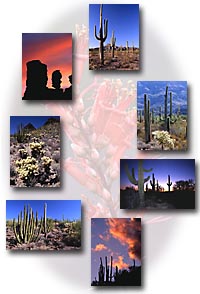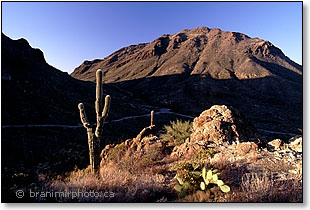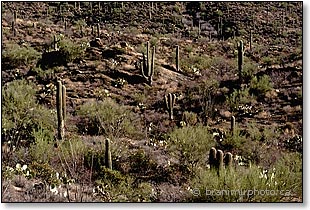
 Saguaro National
Park, Arizona
Saguaro National
Park, Arizona
Saguaro National Park located on the outskirts of Tucson, contains one of the best preserved parts of the Sonoran Desert. Here, visitors have a chance to explore 91,327 acres of rolling hills covered with real forests of the symbol of the American southwest; the saguaro cactus. Other flora and fauna is well represented as well, giving the Sonoran Desert its richness for which it is renown.
The park has two sections: East and West block, each with its unique character. Saguaro East is larger of the two, and located closer to Tucson. It spreads at the foot of the Rincon Mountains, with a more varied terrain than the Saguaro West. The 13 km (8 mi) paved Cactus Forest Drive winds through stands of saguaro next to the Visitor Centre. Over 200 km (128 MI) of trails penetrate the vast desert environment, and provide hiking opportunities with varied levels of difficulty. Backcountry camping is allowed but only at designated sites. Permits are required and can be obtained at the visitor centre. To reach Saguaro East, head east on Speedway Boulevard Turn right on Old Spanish Trail, which will lead to the visitor centre, about 15 minutes from Tucson.
Some say that the Saguaro West is prettier, with nicer stands of saguaro forest. It is definitely easier to access, with several paved roads passing near the park. To get to the Saguaro West, take the Gates Pass Road west through the Tucson Mountains. A scenic overlook at the Gates Pass will give you a glimpse of the rugged terrain that is awaiting you around the corner. The image below was taken shortly after sunrise; be aware that large areas will be covered by shadow from the Tucson Mountains. A word of caution; if you are caught in a sudden rain storm, do not enter or attempt to drive through several wash areas located between the Gates Pass and the Saguaro West.
Red Hills Visitor Centre is located on Kinney Road, about 30 minute drive from Tucson. Here you can obtain hiking information, maps, brochures, and books about desert ecology. The 14.5 km (9 MI) Bajada Loop drive starts near the visitor centre. Four-wheel drive vehicles are not necessary for the 10 km stretch of graded dirt road within the Loop.
Numerous hiking trails branch off access roads and lead deep into the desert. Hugh Norris Trail follows the Red Hills mountain ridge, and offers the most dramatic panorama view of the park. Follow this trail to the highest peak in the Tucson Mountains, the Watson Peak at 1428 m (4687 ft.). Sendero Esperanza Trail is a moderate hike with 600 ft. elevation gain that will allow you to explore the vegetation and views at different levels; from the washes down in the valley all the way up to the top of a saddle west of Amole Peak. Scenic roads and trails sit predominantly on slopes oriented to the west, so afternoons and sunsets offer the best photography opportunities.
Camping is not allowed in the Saguaro West. If you are not staying in one of the hotels or motels in Tucson, the best place to set up your tent is in Gilbert Ray campground. This campground is located in the Tucson County Mountain Park, which shares Saguaro West southern boundary and protects equally beautiful stands of desert vegetation.
Learn more about the Saguaro National Park at www.nps.gov/sagu or view on-line videos (external links).
Places to visit while you are in the area:
Arizona-Sonora Desert Museum (www.desertmuseum.org) just south of the Saguaro West on Kinney Road, exhibits over 300 live animal species in a beautifully designed outdoor setting. You will be able to see and photograph prairie dogs, coyotes, Gila monsters, bighorn sheep, javelinas (a type of wild pig), and mountain lions in a natural setting. Free-flying birds are attracted to ponds and lush vegetation within the compound: cactus wren, Gila woodpecker, and curve-billed trasher among others. Watch for hummingbirds - they are everywhere. More than 1,300 species of plants native to the area are carefully planted to educate visitors about the richness of the Sonoran Desert landscapes. Try to get there as soon as the Museum opens and before the crowds. Admission charged.
Center for Creative Photography at the University of Arizona, Olive Rd. north of 2nd Street in Tucson. The centre houses one of the most comprehensive photographic collections in the world. More than 60,000 photographs representing the work of about 1,400 photographers can be seen in a print-viewing room (advanced booking required). Temporary exhibition displays from the Centre collections and elsewhere. Free.
Old Tucson Studios (www.oldtucson.com) is a replica of 1880s Tucson, built in 1939 for the filming of "Arizona" and decades later used for the movie "Tombstone". More than 300 films, TV episodes, and commercials were filmed here. Staged gunfights, stunt demonstrations, stagecoach rides are highlights. Drive west on Gates Pass Road and when it branches off to Kinney Road, turn south and follow signs. Close to the Gilbert Ray campground. Admission charged.
11 January, 2011
Contact us ![]() Privacy policy
Privacy policy ![]() Terms of use
Terms of use
Copyright © Branimir Gjetvaj, all rights reserved
www.branimirphoto.ca

